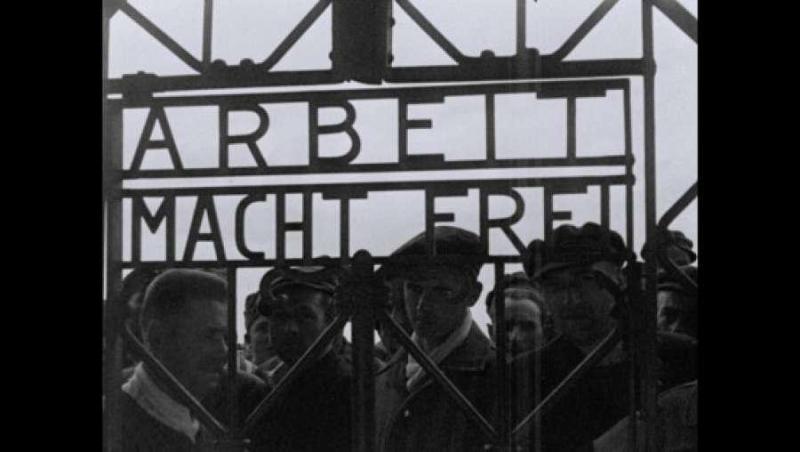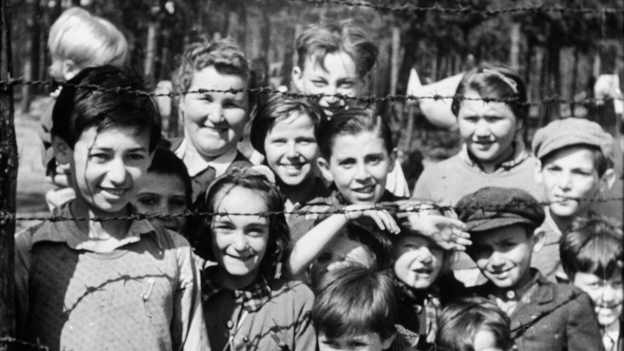DVD/Blu-ray: German Concentration Camps Factual Survey | reviews, news & interviews
DVD/Blu-ray: German Concentration Camps Factual Survey
DVD/Blu-ray: German Concentration Camps Factual Survey
Screening the Holocaust, Sidney Bernstein's devastating documentary completed and restored

This is an impeccably restored presentation of the 1945 feature-length documentary that was intended to be shown in German cinemas in order to counter any remaining support for Nazism.
The assembled film, shot in over 14 locations including Bergen-Belsen and Dachau, did not spare viewers’ sensitivities. Forty-three cameramen shot unflinching footage of piles of skeletal bodies bulldozed into pits, co-opted camp guards lugging corpses past the shocked gaze of the locals, who had been forced to come and see what had been happening behind the barbed wire. The survivors are shown being nursed back to health where possible, although many continued to die in the days and weeks after liberation. It is a deeply disturbing film, made more so by the digital restoration that has removed any flicker, blur or reassuring patina of age; these images could have been shot yesterday.
It was only in 2014 that the original intended ending was edited together
Bernstein drafted in Alfred Hitchcock to advise on style and structure, while philosopher/politician Richard Crossman wrote the commentary script. Their aim was to bear witness and to teach a lesson, as the commentary intones: "We hope that Germans will mend what they have broken and cleanse what they have befouled." Much is made by the BFI and Imperial War Museum, which have jointly restored the film, about it being "lost"; the final reel that used Russian footage from Auschwitz and Majdanek was never completed. It was only in 2014 that the original intended ending was edited together from a contemporary script and cutting notes.
The history of Bernstein’s original production was the subject of 2014’s Night Will Fall, which slightly over-hyped the documentary’s disappearance and claimed that it had been unseen since 1945. This is not exactly the case: a much shorter version under the title of Die Todesmühlen (The Death Mills) was completed by Billy Wilder and the United States Department of War and screened in Germany in 1946, while another longer, partially restored version was shown at the Berlin Film Festival in 1984 and then broadcast with interspersed interviews with its creators on ITV in 1985 under the title A Painful Reminder: Evidence for All Mankind. Yet another version has been available in the USA since 1985 and shown on PBS as Memory of the Camps.
Much of the footage will be familiar – many of the scenes have been widely used as archive in other documentaries and TV programmes about the Final Solution. But there are sequences such as the torching of the typhus-infected barracks and the bald statements by SS officers which are less familiar. What may be more suprising to a younger generation, one which has grown up with the Holocaust as a key element in World War II history, is the film's reticence about the camps' victims.
Bernstein and his colleagues believed that as anti-semitism was still so rife in 1945, it was best not to mention that the vast majority of the dead were Jews. Instead the commentary emphasises that the victims came from all over the world and stressed our universal humanity. Watching the documentary with its original script re-recorded for this version by the actor Jasper Britton (far cooler in delivery than the acerbic tone of the recording by Trevor Howard), brings home yet again the complexities of historical narrative. One always has to consider who is telling the story, from what perspective and for what intended time and audience, never more so than when speaking of these atrocities.
rating
Share this article
Add comment
The future of Arts Journalism
You can stop theartsdesk.com closing!
We urgently need financing to survive. Our fundraising drive has thus far raised £49,000 but we need to reach £100,000 or we will be forced to close. Please contribute here: https://gofund.me/c3f6033d
And if you can forward this information to anyone who might assist, we’d be grateful.

Subscribe to theartsdesk.com
Thank you for continuing to read our work on theartsdesk.com. For unlimited access to every article in its entirety, including our archive of more than 15,000 pieces, we're asking for £5 per month or £40 per year. We feel it's a very good deal, and hope you do too.
To take a subscription now simply click here.
And if you're looking for that extra gift for a friend or family member, why not treat them to a theartsdesk.com gift subscription?
more Film
 theartsdesk Q&A: filmmaker Dag Johan Haugerud on sex, love, and confusion in the modern world
The writer-director discusses first-love agony and ecstasy in 'Dreams', the opening UK installment of his 'Oslo Stories' trilogy
theartsdesk Q&A: filmmaker Dag Johan Haugerud on sex, love, and confusion in the modern world
The writer-director discusses first-love agony and ecstasy in 'Dreams', the opening UK installment of his 'Oslo Stories' trilogy
 Oslo Stories Trilogy: Dreams review - love lessons
First love's bliss begins a utopian city symphony
Oslo Stories Trilogy: Dreams review - love lessons
First love's bliss begins a utopian city symphony
 Blu-ray: Two Way Stretch / Heavens Above!
'Peak Sellers': two gems from a great comic actor in his prime
Blu-ray: Two Way Stretch / Heavens Above!
'Peak Sellers': two gems from a great comic actor in his prime
 Late Shift review - life and death in an understaffed Swiss hospital
Petra Volpe directs Leonie Benesch in a compelling medical drama
Late Shift review - life and death in an understaffed Swiss hospital
Petra Volpe directs Leonie Benesch in a compelling medical drama
 The Naked Gun review - farce, slapstick and crass stupidity
Pamela Anderson and Liam Neeson put a retro spin on the Police Squad files
The Naked Gun review - farce, slapstick and crass stupidity
Pamela Anderson and Liam Neeson put a retro spin on the Police Squad files
 theartsdesk Q&A: actor Lars Eidinger on 'Dying' and loving the second half of life
The German star talks about playing the director's alter ego in a tormented family drama
theartsdesk Q&A: actor Lars Eidinger on 'Dying' and loving the second half of life
The German star talks about playing the director's alter ego in a tormented family drama
 The Fantastic Four: First Steps review - innocence regained
Marvel's original super-group return to fun, idealistic first principles
The Fantastic Four: First Steps review - innocence regained
Marvel's original super-group return to fun, idealistic first principles
 Dying review - they fuck you up, your mum and dad
Family dysfunction is at the heart of a quietly mesmerising German drama
Dying review - they fuck you up, your mum and dad
Family dysfunction is at the heart of a quietly mesmerising German drama
 theartsdesk Q&A: director Athina Rachel Tsangari on her brooding new film 'Harvest'
The Greek filmmaker talks about adapting Jim Crace's novel and putting the mercurial Caleb Landry Jones centre stage
theartsdesk Q&A: director Athina Rachel Tsangari on her brooding new film 'Harvest'
The Greek filmmaker talks about adapting Jim Crace's novel and putting the mercurial Caleb Landry Jones centre stage
 Blu-ray: The Rebel / The Punch and Judy Man
Tony Hancock's two film outings, newly remastered
Blu-ray: The Rebel / The Punch and Judy Man
Tony Hancock's two film outings, newly remastered
 The Ballad of Suzanne Césaire review - a mysterious silence
A black Caribbean Surrealist rebel obliquely remembered
The Ballad of Suzanne Césaire review - a mysterious silence
A black Caribbean Surrealist rebel obliquely remembered
 Harvest review - blood, barley and adaptation
An incandescent novel struggles to light up the screen
Harvest review - blood, barley and adaptation
An incandescent novel struggles to light up the screen

Comments
Not available in the US.